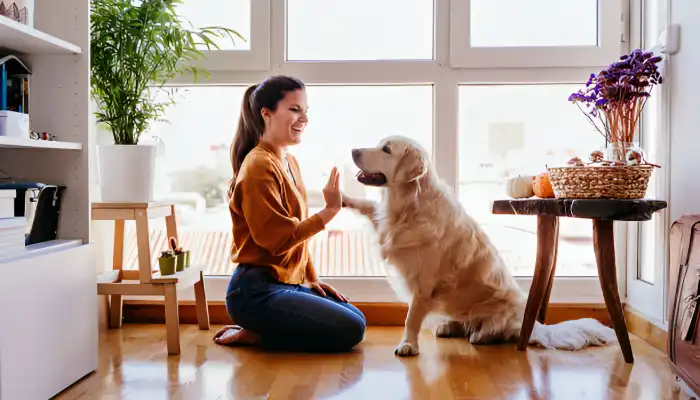Have you thought about how to let out a greeting for your pet? How do you say “Hi” in dog language? Regardless of the fact that dogs don’t talk as human beings do, they have their particular ways of saying greetings and showing love. Knowing these signals may help you embrace the love of your pet even more.
There are dog translators available or you can simply learn canine body language. With this, you will find out how dogs say hello and so much more. This blog will take you through how dogs interact with one another, the ways in which you can interact with your dog, and the changes in their body language when they are excited to meet you.

The Basics of Dog Greetings
Dogs communicate in a variety of ways and dog language of saying ‘hi’ is no exception. It is all dependent on their body language. Unlike humans who might wave their hands or even say “hello”, dogs use their bodies and voice.
Tail Wagging
- Excitement: For a dog, a tail wag means they are happy to see you. The higher the tail is wagged, the faster it wags, this shows excitement and the dog is trying to greet you.
- Relaxed: A neutral tail position or a slow wag suggests calmness and friendliness.
Ear Movements
- Friendly Greeting: Relaxed, upright ears suggest a dog that is at ease and content.
- Alertness: Ears that are raised or turned backward are a sign of alertness or curiosity.
Barking or Whining
- Excited Barking: When very excited, some dogs greet people with a bark that has a high pitch or some form of whining.
- Playful Greeting: A gentle, soft bark could be a way of saying “hello” when the intention is lighthearted fun.
How do you say “Hi” in dog language? With dogs, it is all in the details. Now let’s go on to explore other gestures as well as sounds they make when ‘meeting’ others.
Recognizing the Body Language of Dogs
Every dog has its unique way of greeting a person or even other dogs. As complicated as it may seem, learning these signals can go a long way in assisting you when it comes to communicating with them. Forget Roaming as you do not need to be fluent in dog; understanding their signals will help as
The Play Bow
- What It Means: One of the motions a dog uses is the play bow, which is their friendly way of saying “Hi”. This motion is put across by lowering the front, raising the back, and stretching their legs forward in a way that signals wanting to relax and play.
- How It Looks: The dog stretches its front legs forward, with its rear end up in the air.
Pawing
- Request for Attention: A paw being placed on a human’s leg is a signal indicating that the dog wishes to strike up a conversation with that specific individual. More often than not, this is a gentle gesture.
- Sign of Affection: In the simplest of words, Pawing is the shortened phrase to “let’s connect” or get more personal.
Sniffing
- Getting to Know You: It is also common for dogs to use sniffing as a technique for adopting another dog or even a human. For instance, when next you come across a dog, there is a chance that they may sniff so that they can determine what type of person you are.
- How You Can Respond: You should also encourage and support the dog in bits by allowing them to sniff different parts of your body. Sniffing is one way that dogs express their greetings.
By monitoring these specific behaviors, you can say that you understand how do you say “Hi” in dog language because “dogs are very expressive.” Their body language, like humans, is very meaningful.
How to Say “Hi” to Your Dog?
When it comes to one-on-one interactions with your dog, energy, and voice level must be synchronized. The following tips will assist you in feeling more at ease when saying “Hi” to your furry friend.
1. Approach Calmly
- When getting close to your dog, do it while remaining at the same level as them. Refrain from any sudden movements that may frighten your dog.
- To help your dog feel secure, greet them softly, and gently.
2. Use Eye Contact
- Dogs will usually say hi to you with their eyes. If your dog looks at you with soft eyes, it simply means they like you.
- Soften your eyes and focus gently to make the connection even stronger.
3. Offer a Hand for Sniffing
- Before stroking your dog, allow them to sniff your hand first as it shows good manners to the canine.
4. Use Positive Body Language
- Smile happily while extending your hand, and have a neutral posture.
5. Give Them Light Pets
- Light petting can help reinforce the greeting. Pay attention to where your pet loves to be petted such as the ears or chin area.
You are now able to use the dog language “Hi” in proper terms and manners and your dog reciprocates the action.
Speaking “Hi” in Dog Language With Your Voice
A dog remembers their owner’s voice. Thus, dogs register your voice and any words that follow. Here is how do you say “Hi” in dog language by using your voice.
1. Use a Higher Voice
- Cheerful friendly speech with a high pitch generally yields a happy response from dogs. If you greet the dog in a joyous tone, your pet will feel loved and happy.
2. Calm, Gentle Speech
- For someone who’s shy or perhaps a bit anxious, soothe them by saying softly and gently greeting them. This type of speech will set them at ease.
3. Repeating Common Phrases
- With the passing of time, dogs become accustomed to the phonetics of particular words. Stating in a friendly tone, “Hi” (or your dog’s name) frequently allows your dog to recognize the phonetics as affection.
You can communicate how to say “Hi” in a dog’s way by using your voice and your dog’s body movement, which helps to strengthen your bond with your four-legged friend.
Conclusion
So, How do you say “Hi” in dog language? It involves responding to their body movement, tone of voice, and action. Each and every dog has a way or ways to say Hi which would come in the form of a subtle bark, play bow, tail wag, and more. Knowing and understanding these gestures will help build the bond you have with your dog. You can also bypass the communication barrier using a dog translator or just by listening and picking up their signals to make the greeting experience all the more memorable for your dog.
The next time you come across a dog and want to greet it, remember this guide to interact with it as best as you can. You now know how dogs communicate and knowing how to say “Hi” using dog language will make a difference in how you relate with your dog.
